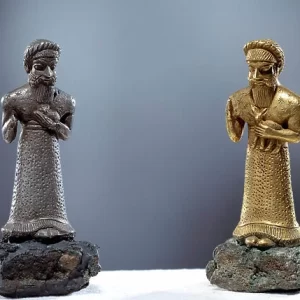Exploring the Intricate Attire of the Minoans: Unveiling the Fashion Traditions of Ancient Crete (3000-1600 BC)
Indeed, the Minoans, an ancient civilization that thrived on the island of Crete from approximately 3000 to 1600 BC, had a fascinating and complex culture. Their clothing played a significant role in expressing their societal structure, beliefs, and artistic sensibilities. While much of our knowledge about Minoan fashion comes from archaeological findings, including frescoes, pottery, and statues, these sources offer valuable insights into their distinctive style.

Minoan attire was characterized by its vibrant colors, intricate patterns, and flowing designs. Both men and women wore garments that were often made from lightweight fabrics, such as linen or wool. The Minoans had access to a rich variety of textiles and dyes, enabling them to create a diverse range of garments.

Women’s clothing in Minoan society typically consisted of a long, flared skirt that reached the ankles, known as a flounced skirt. These skirts were often layered and featured elaborate patterns, such as geometric motifs or nature-inspired designs like flowers and plants. The Minoan women also wore a fitted bodice or corset-like garment on the upper body, which accentuated the waistline. They often adorned themselves with jewelry, including earrings, necklaces, and bracelets.

Minoan men typically wore a loincloth or a kilt-like garment called a schenti, which was made of a rectangular piece of fabric wrapped around the waist and secured with a belt. Men also occasionally wore a vest or short jacket. Both genders frequently donned headdresses, such as turbans or headbands, often decorated with feathers or other adornments.

It’s worth noting that Minoan fashion exhibited a remarkable sense of equality between men and women. Both genders had a wide range of clothing choices, and depictions in Minoan art often show women and men dressed similarly, suggesting a society where gender roles were not as strictly defined as in some other ancient cultures.

The Minoans’ clothing not only served practical purposes but also played a symbolic role. The vibrant colors, intricate patterns, and luxurious textiles used in their garments reflected their sophisticated artistic sensibilities and demonstrated their wealth and social status. Clothing was an essential aspect of Minoan self-expression, as well as a means of conveying cultural identity and aesthetic values.
Overall, Minoan fashion was marked by its creativity, attention to detail, and the celebration of beauty and individuality. Their complex culture, as reflected in their clothing, continues to captivate and inspire us today, providing a window into the vibrant world of the Minoans on the ancient island of Crete.





